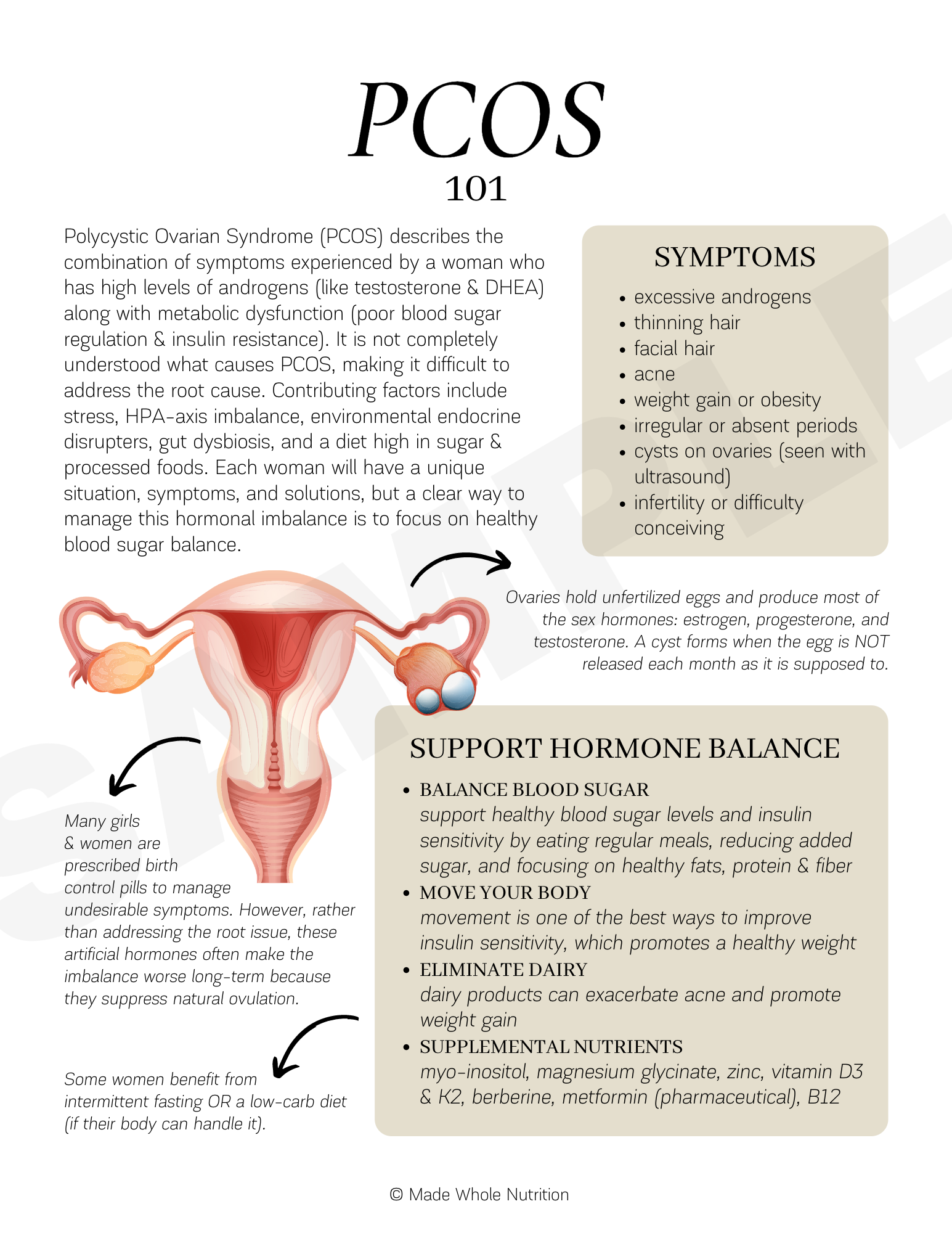A Functional Nutrition Approach to PCOS
WHAT IS PCOS?
Polycystic Ovarian Syndrome (PCOS) describes the combination of symptoms experienced by a woman who has high levels of androgens (like testosterone & DHEA) along with metabolic dysfunction (poor blood sugar regulation & insulin resistance).
WHAT CAUSES PCOS?
It is not completely understood what causes PCOS, making it difficult to address the root cause.
Contributing factors include stress, HPA-axis imbalance, environmental endocrine disrupters, gut dysbiosis, and a diet high in sugar & processed foods.
Each woman will have a unique situation, symptoms, and solutions, but a clear way to manage this hormonal imbalance is to focus on healthy blood sugar balance.
Ovaries hold unfertilized eggs and produce most of the sex hormones: estrogen, progesterone, and testosterone. A cyst forms when the egg is NOT released each month as it is supposed to be.
SYMPTOMS OF PCOS
excessive androgens
thinning hair
facial hair
weight gain or obesity
irregular or absent periods
cysts on ovaries (seen with ultrasound)
infertility or difficulty conceiving
SUPPORT PCOS HORMONE BALANCE
BALANCE BLOOD SUGAR
support healthy blood sugar levels & insulin sensitivity by eating regular meals, reducing added sugar, & focusing on healthy fats, protein & fiber
MOVE YOUR BODY
movement is one of the best ways to improve insulin sensitivity, which promotes a healthy weight
ELIMINATE DAIRY
dairy products can exacerbate acne & promote weight gain
SUPPLEMENTAL NUTRIENTS
myo-inositol, magnesium glycinate, zinc, vitamin D3 & K2, berberine, metformin (pharmaceutical), B12
*some women benefit from intermittent fasting OR a low-carb diet (if their body can handle it)
Many girls & women are prescribed birth control pills to manage undesirable symptoms. However, rather than addressing the root issue, these artificial hormones often make the imbalance worse long-term because they suppress natural ovulation.
Are you a health educator that wants to use this content with your clients? Customize the handout template in less time than it would take to even think about hiring a graphic designer.
References
Polycystic Ovarian Syndrome (PCOS). Cleveland Clinic. Retrieved from https://my.clevelandclinic.org/health/diseases/8316-polycystic-ovary-syndrome-pcos
U.S. Department of Health and Human Services. Office of Dietary Supplements. NIH Office of Dietary Supplements. Retrieved from https://ods.od.nih.gov/factsheets/list-all/
Jones, D. S., Bland, J. S., & Quinn, S. (2010). Textbook of Functional Medicine. Institute for Functional Medicine.Gaby, A. R. (2017). Nutritional Medicine (2nd ed.). Fritz Perlberg Publishing.
Artini, P. G., Malacarne, E., Tomatis, V., & Genazzani, A. D. (2021). The relevance of inositols treatment for PCOS before and during ART. European Review for Medical and Pharmacological Sciences, 25(14), 4799–4809. https://doi-org.uws.idm.oclc.org/10.26355/eurrev_202107_26393
Caputo, M., Bona, E., Leone, I., Samà, M. T., Nuzzo, A., Ferrero, A., Aimaretti, G., Marzullo, P., & Prodam, F. (2020). Inositols and metabolic disorders: From farm to bedside. Journal of traditional and complementary medicine, 10(3), 252–259. https://doi.org/10.1016/j.jtcme.2020.03.005
Pkhaladze, L., Russo, M., Unfer, V., Nordio, M., Basciani, S., & Khomasuridze, A. (2021). Treatment of lean PCOS teenagers: a follow-up comparison between Myo-Inositol and oral contraceptives. European Review for Medical and Pharmacological Sciences, 25(23), 7476–7485. https://doi-org.uws.idm.oclc.org/10.26355/eurrev_202112_27447







